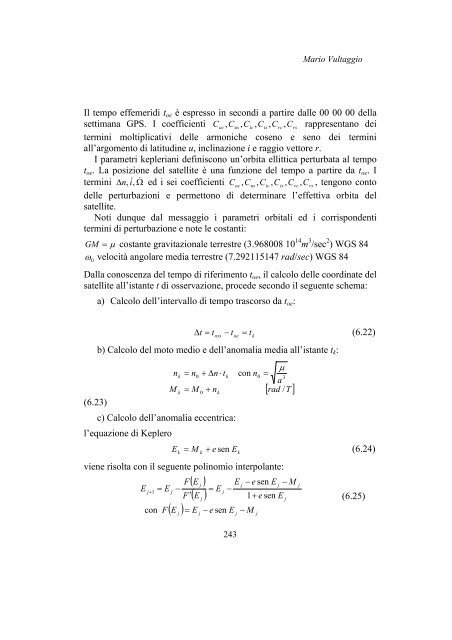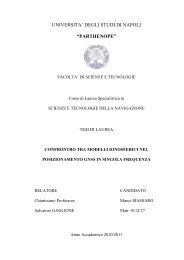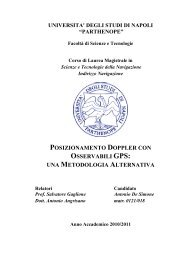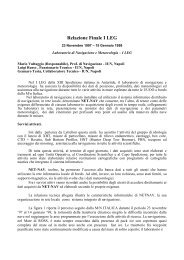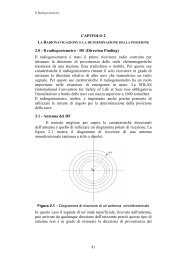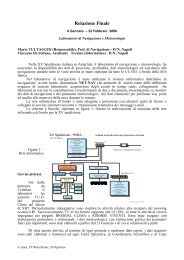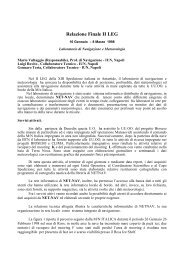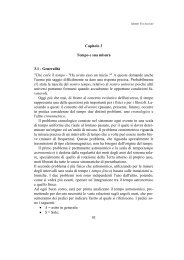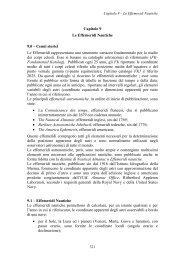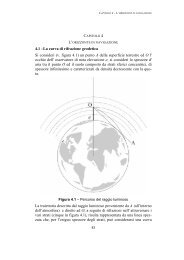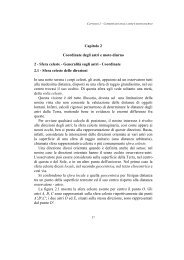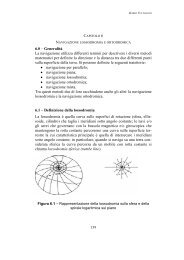Capitolo 6 Il Sistema Satellitare GPS 6.1 – Descrizione del sistema ...
Capitolo 6 Il Sistema Satellitare GPS 6.1 – Descrizione del sistema ...
Capitolo 6 Il Sistema Satellitare GPS 6.1 – Descrizione del sistema ...
You also want an ePaper? Increase the reach of your titles
YUMPU automatically turns print PDFs into web optimized ePapers that Google loves.
243<br />
Mario Vultaggio<br />
<strong>Il</strong> tempo effemeridi toe è espresso in secondi a partire dalle 00 00 00 <strong>del</strong>la<br />
settimana <strong>GPS</strong>. I coefficienti C uc , Cus<br />
, Cic<br />
, Cis<br />
, Crc<br />
, Crs<br />
rappresentano dei<br />
termini moltiplicativi <strong>del</strong>le armoniche coseno e seno dei termini<br />
all’argomento di latitudine u, inclinazione i e raggio vettore r.<br />
I parametri kepleriani definiscono un’orbita ellittica perturbata al tempo<br />
toe. La posizione <strong>del</strong> satellite è una funzione <strong>del</strong> tempo a partire da toe. I<br />
termini Δn<br />
, i&<br />
, Ω&<br />
ed i sei coefficienti C uc , Cus<br />
, Cic<br />
, Cis<br />
, Crc<br />
, Crs<br />
, tengono conto<br />
<strong>del</strong>le perturbazioni e permettono di determinare l’effettiva orbita <strong>del</strong><br />
satellite.<br />
Noti dunque dal messaggio i parametri orbitali ed i corrispondenti<br />
termini di perturbazione e note le costanti:<br />
GM = μ costante gravitazionale terrestre (3.968008 10 14 m 3 /sec 2 ) WGS 84<br />
ω 0 velocità angolare media terrestre (7.292115147 rad/sec) WGS 84<br />
Dalla conoscenza <strong>del</strong> tempo di riferimento toe, il calcolo <strong>del</strong>le coordinate <strong>del</strong><br />
satellite all’istante t di osservazione, procede secondo il seguente schema:<br />
a) Calcolo <strong>del</strong>l’intervallo di tempo trascorso da toe:<br />
Δ t = t − t = t<br />
(6.22)<br />
oss<br />
b) Calcolo <strong>del</strong> moto medio e <strong>del</strong>l’anomalia media all’istante tk:<br />
nk<br />
= n0<br />
+ Δn<br />
⋅ tk<br />
con n0<br />
M k = M 0 + nk<br />
(6.23)<br />
c) Calcolo <strong>del</strong>l’anomalia eccentrica:<br />
l’equazione di Keplero<br />
k<br />
k<br />
oe<br />
k<br />
k<br />
=<br />
μ<br />
3<br />
a<br />
[ rad / T ]<br />
E = M + e sen E<br />
(6.24)<br />
viene risolta con il seguente polinomio interpolante:<br />
E<br />
j+<br />
1<br />
con<br />
= E<br />
F<br />
F(<br />
E j ) E j − e<br />
j − = E j −<br />
F′<br />
( E j ) 1+<br />
( E j ) = E j − e sen E j − M j<br />
sen E<br />
j<br />
e sen E<br />
− M<br />
j<br />
j<br />
(6.25)


